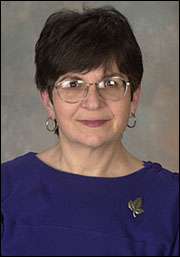|
 Estelle Levetin Estelle Levetin
|
Department Chair
-B.S. (Ed.), State College at Boston
-Ph.D., Rhode Island
Office: 304 Oliphant
Hall
Phone: (918) 631-2764
Email: estelle-levetin@utulsa.edu
|
|
Research Interests:
The research in my laboratory is largely in the field of Aerobiology,
often considered the "microbiology" of the atmosphere. Aerobiology is the study of the movement of biological
particles (bioaerosols) or products of organisms within the atmosphere or the indoor environment. By its very nature,
the field of aerobiology is interdisciplinary with meteorology and aerosol physics at its core and with applications
in the fields of agriculture, plant pathology, allergy, public health, immunology, palynology, biochemistry, and
microbiology. Within the field of aerobiology, my research has been focused on the study of airborne allergens.
On-going aerobiology projects in my lab can be grouped in the following areas:
- Outdoor aerobiology of spores and pollen with an emphasis on the influence
of wind on the long-distance transport of allergenic pollen and also the influence of meteorological factors on
the atmospheric concentration of ascospores, basidiospores and smut spores
- The effect of UV-light on reducing fungal contamination within air handling
units of central HVAC (Heating Ventilation and Air Conditioning) systems
- Fungal allergens in the indoor environment with an emphasis on those groups
of fungi that have been poorly studied
- The isolation, characterization and biochemistry of the allergenic molecules
from spores or pollen with an emphasis on the allergens present in conifer pollen, basidiospores, smut spores,
and conidia of Penicillium and Aspergillus species
- Comparison of pollen influx (the incorporate of pollen into sediments)
with airborne pollen concentrations
Many of my outdoor aerobiology projects have involved environmental applications
of the Oklahoma Mesonet. The Oklahoma Mesonet is a system of 115 automated environmental monitoring stations spaced
an average of 32 km apart across Oklahoma. Multiple sensors at each Mesonet site provide observations at either
5 min. or 15 min. intervals. The observations are transmitted to a central site at OU in Norman every 15 min.,
archived, and then made available on-line. Meteorological parameters measured include solar radiation, temperature,
rainfall, barometric pressure, and wind speed and direction at two levels on a 10 meter tower. The availability
of Mesonet data facilitates tracking the movement of pollen and spore-laden parcels of air. Air samplers are now
located at four Mesonet sites within the state. The focus in my lab has been on understanding the influence of
wind on the long-distance transport of allergenic pollen and fungal spores into the Tulsa atmosphere. A second
focus is to examine the effects of humidity, rainfall, and other meteorological parameters on the concentration
of aeroallergens.
Conifer pollen allergens
- I have had an ongoing interest in conifer pollen allergens for the past 17 years. Mountain cedar (Juniperus ashei)
pollen is one of the most potent allergens in the United States. Populations of mountain cedar occur in south central
Oklahoma and Texas. Although none occur within 200 miles of Tulsa, my lab has presented evidence for significant
concentrations of mountain cedar pollen being carried to Tulsa by prevailing southerly winds. During the mountain
cedar pollen season we are providing daily pollen forecasts. Research in my lab has also focused on the identification
of the specific allergenic proteins in mountain cedar pollen and related species of conifers.
ENVIRONMENTAL MICROBIOLOGY
My lab has also been involved in some non-aerobiological investigations in which the focus has been on soil fungi,
especially the microbial ecology of the Tallgrass Prairie. Various researchers at The University of Tulsa are involved
in the bioremediation of brine and petroleum spills at the Tallgrass Prairie Preserve in Pawhuska, Oklahoma. My
lab has been interested in studying the effect of both the contamination as well as the effect of the bioremediation
process itself on the soil microfungi.
Teaching Fields:
- Biol 1013 - Plants and Society
- Biol 3314 - Fungi and Algae
- Biol 3454 - Plant Anatomy
- Biol 3464 - Plant Physiology
- Biol 3504 - Higher Plants
- Biol 4023 - Environmental Microbiology
Selected Publications:
- Sterling, M., C. Rogers, and E. Levetin,1999. An Evaluation of two methods
used for microscopic analysis of airborne fungal spore concentrations from the Burkard Spore Trap. Aerobiologia
15: 9-18.
- Rogers, C. and E. Levetin, 1998. Evidence of long-distance transport of
mountain cedar pollen into Tulsa, Oklahoma. Int. J. Biometeorol, 42: 65-72.
- Levetin, E., 1998. A long-term study of winter and early spring tree pollen
in the Tulsa, Oklahoma atmosphere. Aerobiologia 14: 21-28.
- Pettyjohn, M. and E. Levetin, 1997. Comparative biochemical study of conifer
pollen allergens. Aerobiologia 13 (4)
259-267.
- Levetin, E and R. Shaugnessy, 1997. Myrothecium, A New indoor air contaminant?
Aerobiologia 13 (4)
227-234.
- cenhour (Perry), C. and E. Levetin, 1997. Penicillium and Aspergillus
species in the habitats of allergy patients in the Tulsa, Oklahoma Area, Aerobiologia, 13 (3) 161-166
- Portman, R., R. Moseman, and E. Levetin, 1997. Surface ornamentation and
basidiospore morphology in the genus Calvatia, Mycotaxon 62:435-443.
- Levetin, E., 1997. Aerobiology of Agricultural Pathogens. In Manual of
Environmental Microbiology, (Eds, Hurst, Knudson, McInerney, Stetzenbach, and Walter), ASM Press, Washington, D.C.,
pp 693-702.
- Crotzer, V. and E. Levetin, 1996. The aerobiological significance of smut
spores in Tulsa, Oklahoma. Aerobiologia. 12: 177-184.
- Pettyjohn, M. and E. Levetin, 1996. Conifer pollen: Is a reassessment
in order. In: Aerobiology (Muilenberg and Burge, ed) Lewis Publishers, Boca Raton, pp 109-122.
- Levetin, E., 1995. "Fungi". In: Bioaerosols, ed. H. Burge, Lewis
Publishers, Boca Raton pp: 87-120.
- Levetin, E., R. Shaughnessy, E. Fisher, B. Ligman, J. Harrison, T. Brennan,
1995. Indoor air quality in schools: Exposure to fungal allergens. Aerobiologia 11 (1) 27-34.
Research Students and Projects:
- Micah Burch (undergraduate student): Influence of meteorological conditions
on spore plumes
- Cashel Troutt (undergraduate student): Spring air spora
- C. Dirk Engles (undergraduate student): Mountain cedar pollen from Bixby
and Hectorville
|

